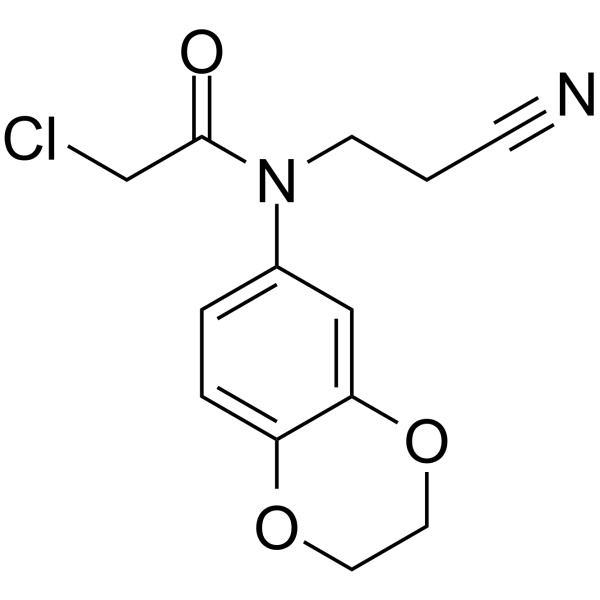
EN106
CAS No. 757192-67-9
EN106( ZINC3888023 )
Catalog No. M28542 CAS No. 757192-67-9
EN106 is a potent inhibitor of FEMIB and is a cysteine-reactive covalent ligand. EN106 disrupts recognition of the key reductive stress substrate of FEM1B, FNIP1.
Purity : >98% (HPLC)
 COA
COA
 Datasheet
Datasheet
 HNMR
HNMR
 HPLC
HPLC
 MSDS
MSDS
 Handing Instructions
Handing Instructions
| Size | Price / USD | Stock | Quantity |
| 5MG | 42 | Get Quote |


|
| 10MG | 67 | Get Quote |


|
| 25MG | 133 | Get Quote |


|
| 50MG | 209 | Get Quote |


|
| 100MG | 337 | Get Quote |


|
| 200MG | Get Quote | Get Quote |


|
| 500MG | Get Quote | Get Quote |


|
| 1G | Get Quote | Get Quote |


|
Biological Information
-
Product NameEN106
-
NoteResearch use only, not for human use.
-
Brief DescriptionEN106 is a potent inhibitor of FEMIB and is a cysteine-reactive covalent ligand. EN106 disrupts recognition of the key reductive stress substrate of FEM1B, FNIP1.
-
DescriptionEN106 is a potent inhibitor of FEMIB and is a cysteine-reactive covalent ligand. EN106 disrupts recognition of the key reductive stress substrate of FEM1B, FNIP1.
-
In Vitro——
-
In Vivo——
-
SynonymsZINC3888023
-
PathwayOthers
-
TargetOther Targets
-
Recptor——
-
Research Area——
-
Indication——
Chemical Information
-
CAS Number757192-67-9
-
Formula Weight280.71
-
Molecular FormulaC13H13ClN2O3
-
Purity>98% (HPLC)
-
SolubilityIn Vitro:?DMSO : 250 mg/mL (890.60 mM)
-
SMILESClCC(=O)N(CCC#N)c1ccc2OCCOc2c1
-
Chemical Name——
Shipping & Storage Information
-
Storage(-20℃)
-
ShippingWith Ice Pack
-
Stability≥ 2 years
Reference
1.Przegaliński E, et al. On the central antiserotonin activity of benzoctamine and opipramol. Pol J Pharmacol Pharm. 1978;30(6):781-790.
molnova catalog



related products
-
WAY-213613 hydrochlo...
WAY-213613 hydrochloride is a selective nonsubstrate reuptake GLT-1/EAAT2 inhibitor (IC50: 85 nM, EAAT2).
-
C- Myc peptide epito...
C- Myc peptide epitope
-
Neuromedin S (human)
Neuromedin S (human) is a neuropeptide that contains 33 amino acids. Neuromedin S (human)has been identified in the brain as an endogenous ligand for the orphan G-protein coupled receptor (GPCR) FM-4/TGR-1 and acts on the neuromedin U (NMU) receptor 2 (NMUR2) in the regulation of body weight homeostasis.



 Cart
Cart
 sales@molnova.com
sales@molnova.com


